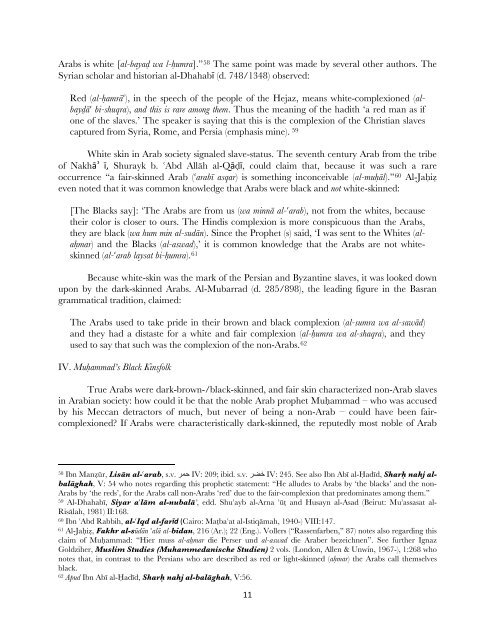“Anyone who says that the Prophet is black should be killed”: The ...
“Anyone who says that the Prophet is black should be killed”: The ...
“Anyone who says that the Prophet is black should be killed”: The ...
You also want an ePaper? Increase the reach of your titles
YUMPU automatically turns print PDFs into web optimized ePapers that Google loves.
Arabs <strong>is</strong> white [al-baya∙ wa l-Èumra].” 58 <strong>The</strong> same point was made by several o<strong>the</strong>r authors. <strong>The</strong><br />
Syrian scholar and h<strong>is</strong>torian al-Dhahabī (d. 748/1348) observed:<br />
Red (al-Èamr§#), in <strong>the</strong> speech of <strong>the</strong> people of <strong>the</strong> Hejaz, means white-complexioned (albay∙§#<br />
bi-shuqra), and th<strong>is</strong> <strong>is</strong> rare among <strong>the</strong>m. Thus <strong>the</strong> meaning of <strong>the</strong> hadith ‘a red man as if<br />
one of <strong>the</strong> slaves.’ <strong>The</strong> speaker <strong>is</strong> saying <strong>that</strong> th<strong>is</strong> <strong>is</strong> <strong>the</strong> complexion of <strong>the</strong> Chr<strong>is</strong>tian slaves<br />
captured from Syria, Rome, and Persia (emphas<strong>is</strong> mine). 59<br />
White skin in Arab society signaled slave-status. <strong>The</strong> seventh century Arab from <strong>the</strong> tri<strong>be</strong><br />
of Nakhāʾ ī, Shurayk b. #Abd All§h al-Qā∙ī, could claim <strong>that</strong>, <strong>be</strong>cause it was such a rare<br />
occurrence “a fair-skinned Arab (#arabÊ asqar) <strong>is</strong> something inconceivable (al-muȧl).” 60 Al-JaÈií<br />
even noted <strong>that</strong> it was common knowledge <strong>that</strong> Arabs were <strong>black</strong> and not white-skinned:<br />
[<strong>The</strong> Blacks say]: ‘<strong>The</strong> Arabs are from us (wa minn§ al-#arab), not from <strong>the</strong> whites, <strong>be</strong>cause<br />
<strong>the</strong>ir color <strong>is</strong> closer to ours. <strong>The</strong> Hind<strong>is</strong> complexion <strong>is</strong> more conspicuous than <strong>the</strong> Arabs,<br />
<strong>the</strong>y are <strong>black</strong> (wa hum min al-sud§n). Since <strong>the</strong> <strong>Prophet</strong> (s) said, ‘I was sent to <strong>the</strong> Whites (alaÈmar)<br />
and <strong>the</strong> Blacks (al-aswad),’ it <strong>is</strong> common knowledge <strong>that</strong> <strong>the</strong> Arabs are not whiteskinned<br />
(al-#arab laysat bi-Èumra). 61<br />
Because white-skin was <strong>the</strong> mark of <strong>the</strong> Persian and Byzantine slaves, it was looked down<br />
upon by <strong>the</strong> dark-skinned Arabs. Al-Mubarrad (d. 285/898), <strong>the</strong> leading figure in <strong>the</strong> Basran<br />
grammatical tradition, claimed:<br />
<strong>The</strong> Arabs used to take pride in <strong>the</strong>ir brown and <strong>black</strong> complexion (al-sumra wa al-saw§d)<br />
and <strong>the</strong>y had a d<strong>is</strong>taste for a white and fair complexion (al-Èumra wa al-shaqra), and <strong>the</strong>y<br />
used to say <strong>that</strong> such was <strong>the</strong> complexion of <strong>the</strong> non-Arabs. 62<br />
IV. MuÈammad’s Black Kinsfolk<br />
True Arabs were dark-brown-/<strong>black</strong>-skinned, and fair skin characterized non-Arab slaves<br />
in Arabian society: how could it <strong>be</strong> <strong>that</strong> <strong>the</strong> noble Arab prophet MuÈammad – <strong>who</strong> was accused<br />
by h<strong>is</strong> Meccan detractors of much, but never of <strong>be</strong>ing a non-Arab – could have <strong>be</strong>en faircomplexioned?<br />
If Arabs were character<strong>is</strong>tically dark-skinned, <strong>the</strong> reputedly most noble of Arab<br />
58 Ibn Maníår, L<strong>is</strong>§n al-#arab, s.v. ﺮﻤﺣ IV: 209; ibid. s.v. ﺮﻀﺧ IV: 245. See also Ibn AbÊ al-\adÊd, SharÈ nahj albal§ghah,<br />
V: 54 <strong>who</strong> notes regarding th<strong>is</strong> prophetic statement: “He alludes to Arabs by ‘<strong>the</strong> <strong>black</strong>s’ and <strong>the</strong> non-<br />
Arabs by ‘<strong>the</strong> reds’, for <strong>the</strong> Arabs call non-Arabs ‘red’ due to <strong>the</strong> fair-complexion <strong>that</strong> predominates among <strong>the</strong>m.”<br />
59 Al-DhahabÊ, Siyar a#l§m al-nubal§", edd. Shu#ayb al-Arna "åã and Husayn al-Asad (Beirut: Mu"assasat al-<br />
R<strong>is</strong>§lah, 1981) II:168.<br />
60 Ibn #Abd Rabbih, al-#Iqd al-farīd (Cairo: Maãba#at al-Istiq§mah, 1940-) VIII:147.<br />
61 Al-JaÈií, Fakhr al-såd§n #al§ al-bidan, 216 (Ar.); 22 (Eng.). Vollers (“Rassenfar<strong>be</strong>n,” 87) notes also regarding th<strong>is</strong><br />
claim of MuÈammad: “Hier muss al-aÈmar die Perser und al-aswad die Ara<strong>be</strong>r <strong>be</strong>zeichnen”. See fur<strong>the</strong>r Ignaz<br />
Goldziher, Muslim Studies (Muhammedan<strong>is</strong>che Studien) 2 vols. (London, Allen & Unwin, 1967-), 1:268 <strong>who</strong><br />
notes <strong>that</strong>, in contrast to <strong>the</strong> Persians <strong>who</strong> are descri<strong>be</strong>d as red or light-skinned (aÈmar) <strong>the</strong> Arabs call <strong>the</strong>mselves<br />
<strong>black</strong>.<br />
62 Apud Ibn AbÊ al-\adÊd, SharÈ nahj al-bal§ghah, V:56.<br />
11
















